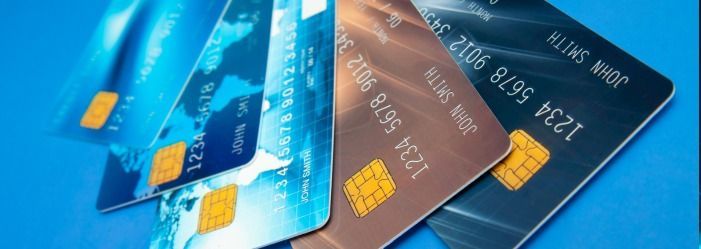Last Updated: March 21, 2024
Understand How Your Credit Card Works

Disclaimer: We are not qualified legal or tax professionals and are not giving advice. Always speak with a qualified professional before making any legal or financial decisions.
Understanding the jargon associated with credit cards is crucial for effective financial management and making informed decisions.
From learning interest rates to avoiding unnecessary fees, the terminology can often seem daunting. This guide clarifies the most common credit card terms, providing you with the knowledge to confidently manage your credit.
Whether you’re a new cardholder or looking to optimize your credit card usage, let’s break down these essential terms into clear, understandable concepts, helping you achieve financial wellness.
Want to skip the article and speak directly to a debt specialist? Click here for a free consultation.
What is a Credit Card?
The first definition to define a credit card. A credit card is a revolving loan that you can use to make purchases. You pay it back in part or in full each month. The credit card company charges you to borrow the money (APR) and they also make a lot of money on fees and penalties.
Let's take a look at some of the credit card terms you will find on your cardholder agreement or in the tiny font on the back of your credit card bill.
Annual Percentage Rate (APR)
The annual percentage rate is one of the most important credit card terms. The APR is the amount of money that the credit card company charges you for making purchases with the card.
APR roughly works as follows: you make a purchase and do not pay it off. The credit card company takes the APR divides by 365 and multiples it by your purchase and you are charged interest. You now owe the purchase plus the day's APR, and it builds each day. To make it clearer, here is an example: Credit card APR: 15.56% Purchase: $1000 Daily APR: 0.043% - you pay about $0.43 a day for each day After 1 month, you owe: $1012.97
There are a number of APRs including interest charges and finance charges, so let's look at each separately.
- Purchase APR - this APR is determined in part by your credit score. The better your credit score, the lower your APR. The average APR as of May 3, 2021 ranges between 15.56% and 22.87%.
- Balance-transfer APR - if you transfer one credit card balance onto another credit card, the balance transfer credit card will offer a lower, often 0% balance transfer for a set time period. The catch is that after the set time period, the interest rate often reverts to a normal APR. Always understand how much the balance transfer fee is.
- Cash Advance APR - if you borrow cash from your card, that amount is charged a higher than normal APR, beginning the day you borrow the money.
- Introductory APR - some credit cards will offer a low introductory APR to get you to acquire one of their cards. They will then raise the APR to a normal or higher than normal APR after the introductory period ends.
- Penalty APR - if you miss a payment, pay late, or use more than your credit limit (over limit fees), you may have a penalty APR applied, often ranging between 27% and 35%. This is higher than your normal APR and may revert back to the normal APR if you do not miss a payment or go over the limit.
- Variable APR - this APR varies with the prime rate and may increase or decrease as the Federal Reserve changes the prime rate. A credit card may have a fixed or a variable APR for any or all of the APRs that they charge.
- Fixed APR - this does not vary with the prime rate, although a card issuer can change your APR after written notification.
Balance or Revolving Balance
The balance or revolving is whatever you are carrying on your credit card. For instance, if you have a limit of $1000 and owe $750, you pay $100, your revolving balance is $650.
You will pay APR on this revolving balance until you pay it in full. If you exceed your line of credit, you will be assessed an over limit fee.
Your balance includes all unpaid purchases, cash advances, penalties, fees and APR.
Balance Transfer Fees
A balance transfer fee involves moving one credit card balance onto another credit card. Many cards offer 0% APR on balance transfers for a set period of time. This allows you to pay off a balance faster because you are temporarily not occurring interest on the balance.
It is possible to avoid balance transfer fees by searching the internet - just read the fine print as the interest rate can be very high.
Billing Cycle
Billing cycles are the amount of time between the closing date of the last statement and the closing date of the next statement. The billing cycle must be at least 21 days.
Cash Advance Fee
A cash advance involves borrowing cash from your credit card. The interest rate and cash advance fees are extremely high and there is no grace period. You accrue interest the day you borrow the money. Avoid cash advance fees by not taking out any cash advances.
Credit Limit
This is the amount of money that credit card issuers are willing to lend you. It is based in part on whether or not your credit report and whether the company feels like you will repay the money.
As you make purchases, you have less money to spend until you repay it. You may see credit limit, credit line, or line of credit - they all mean the same thing.
If your credit report is bad or your history is thin, you may apply for a secured credit card. You put a certain amount of money into an escrowed savings account with the credit card company and that amount becomes your credit limit. As long as you pay back the credit card, the money stays in the escrowed bank account.
If you miss a payment, the credit card company takes money from escrow and your credit limit drops to whatever amount is left.
Credit Score and Credit Report
We have addressed credit scores in great detail in a previous article. The short version is that your credit score looks at your history of paying back loans on time and in full. The more responsible you are, the higher your credit score. A good credit score is a measure of responsibility, not of financial health. The better your credit score, the easier you will find it when borrowing money.
All your data is put into a report that lists all your loans, your payment history, and other information. By paying your credit card bill on time, you will only help your credit score. Missed payments immediately hurt your credit score.
Due Date
The due date is the date your payment must be received, usually by 5 p.m. in the credit card issuer's time zone. If you miss the due date, you will receive late fees and possibly a penalty. If you continue to miss due dates, you will be reported to the credit bureaus and this lowers your credit score.
Make a payment before the day it is due - there have been instances where the payment was not processed until the next day and the payment was considered “late.”
Grace Period
This is the amount of time that you have to make a purchase and pay it off without incurring any interest charges. This is legally no less than 21 days.
Fees
Credit card companies make most of their profit off fees. Expect a lot of fees! Here are a few common credit card fees:
- Annual Fee - annual fee is a yearly charge that you pay for the privilege of using a credit card. Not all cards have annual fees. Those that do often come with perks that make up for the annual fee. Credit card annual fees vary from $25 to $500 per year per card. To avoid annual fees, look for a card without the annual fee.
- Late Payment (late fees) - if you are late making a payment, you will be charged a late payment fee. These range between $15 and $37 or a percentage of your balance, whichever is larger. Missed payment fees may be included in this fee section. Credit card late fees add up very quickly.
- Foreign Transaction Fees - if you make purchases outside the US, you are charged a foreign transaction fee, usually 3% of your purchases. Some cards do not charge these, so if you travel a good deal, look for a card without a foreign transaction fee. You may be able to get a good exchange rate for foreign currency.
- Cash Advance - this fee is charged on cash advances and is 5% of the advance or $10, whichever is greatest.
- Balance Transfer Fee - a percentage based fee based on how much you transfer from one credit card to another.
- Returned Payment Fees - if you bounce a check for a credit card payment or do not have enough money in your bank account to make your automatic payments, you will be charged a returned payment fee. Avoid returned payment fees by making certain you have money in your checking account.
- Card Replacement Fees - if you lose your credit card, you may be charged a replacement fee.
Minimum Payment
The minimum payment is the lowest amount you can pay each month on your card. It is usually between 1% and 3% of your outstanding balance or $25, whichever is higher. If you make only minimum payments, you will take years to pay off credit card balances.
Security Code (CVV)
Your security code is on the back of your card (except for Amex which is on the front). When you make an online purchase, you are asked for your CVV. This verifies that you are the owner of the credit card and gives you a bit of security from credit card fraud.
FAQs
Pacific Debt, Inc.
If you have overused your credit cards and cannot make even your minimum payments, Pacific Debt, Inc can help.
Pacific Debt, Inc is an award winning debt settlement company. If you'd like more information on how to get out of debt, we are happy to help. We will explain all your options and help you decide which is the best option for you. We can even refer you to trusted partners who can better meet your needs.
If you have more questions, contact one of our debt specialists today. The initial consultation is free, and our debt experts will explain your options to you.
*Disclaimer: Pacific Debt Relief explicitly states that it is not a credit repair organization, and its program does not aim to improve individuals' credit scores. The information provided here is intended solely for educational purposes, aiding consumers in making informed decisions regarding credit and debt matters. The content herein does not constitute legal or financial advice. Pacific Debt Relief strongly advises individuals to seek the counsel of qualified professionals before undertaking any legal or financial actions.
✔ Accredited by Better Business Bureau with BBB A+ rating (4.93 rating and 1678 reviews)
✔ US News and World Reports and Bankrate ranked Pacific Debt Relief as one of “The Best Debt Relief Companies of 2024”
✔ 6.9 star rating by BestCompany.com (over 2379 client reviews)
✔ 4.8 star rating by TrustPilot based (over 1613 verified consumer reviews)
✔ ConsumerAffairs.com Accredited (over 544 verified reviews with an average rating of 5 stars)
✔ A Top 10 Rated Compan by TopTenReviews.com , ConsumersAdvocate.com and Top10debtconsolidation.com
✔ 4.6 star rating by Google (229 client reviews)
✔ 100% rating by SuperMoney (9 client reviews)
Reduce Your Credit Card Debt By Up to Half

BBB Reviews | 4.9/5.0 Rating









 Do Not Sell My Personal Information
Do Not Sell My Personal Information